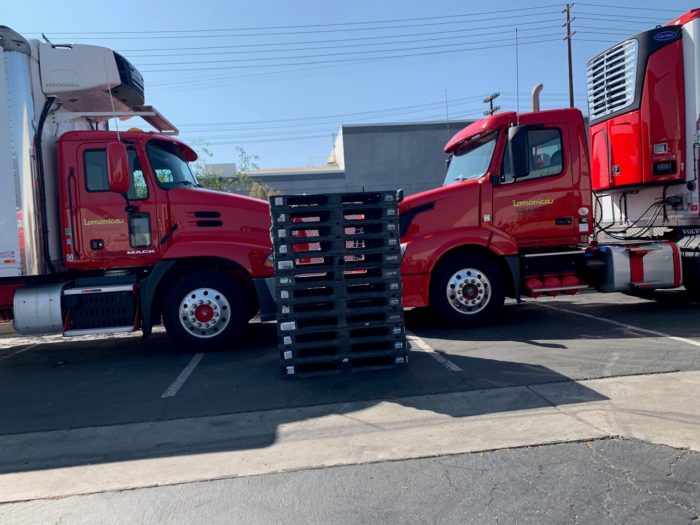Achieving sustainability across supply chains is a major objective for businesses across the globe. There has been an estimated 24% increase in the number of companies asking suppliers for reports on environmental data. With freight transportation being a major contributor to costs and air pollution, businesses are focusing on sustainable logistics management practices more than ever to reduce their carbon footprints.
Logistics Management Practices to Improve Sustainability
 When a business minimizes its carbon footprint across the supply chain, it doesn’t only increase profitability. It also helps create an environmentally-friendly brand image. And when it comes to choosing brands nowadays, customers are increasingly aware of the environmental impact of the products they use. This awareness is reflected in customer preferences throughout the supermarket aisles. According to a study conducted by IBM and the National Retail Federation, about 70% of customers in the U.S. and Canada consider the sustainability of a brand as an important factor and are willing to pay more for environmentally-friendly brands. As customers continue to make sustainable choices, they underscore the need for businesses to implement sustainable logistics management practices in the supply chain. Here are a few practices that logistics managers can follow to create more sustainable supply chains.
When a business minimizes its carbon footprint across the supply chain, it doesn’t only increase profitability. It also helps create an environmentally-friendly brand image. And when it comes to choosing brands nowadays, customers are increasingly aware of the environmental impact of the products they use. This awareness is reflected in customer preferences throughout the supermarket aisles. According to a study conducted by IBM and the National Retail Federation, about 70% of customers in the U.S. and Canada consider the sustainability of a brand as an important factor and are willing to pay more for environmentally-friendly brands. As customers continue to make sustainable choices, they underscore the need for businesses to implement sustainable logistics management practices in the supply chain. Here are a few practices that logistics managers can follow to create more sustainable supply chains.
Increase Transparency in Logistics
As supply chains become more complex, managers can find it difficult to keep track of transporting loads and vehicles. Outsourcing transport operations to third-party logistics companies introduces its own complications by obscuring visibility across the supply chain. To assist in track-and-trace shipments, transport managers can increase transparency in logistics through uniform tracking methods such as the usage of Warehouse Management Systems (WMS) along with barcodes or radio frequency identification (RFID).
Optimize Transportation Planning and Performance
By reducing the number of empty transportation legs in the supply chain, companies can realize significant cost savings. The empty miles that accrue from “deadhead trucking” result in unproductive and unnecessary fuel costs and drivers’ wages. Often, the underlying reason for empty miles can be traced to poorly planned transportation routes for sourcing raw materials or delivering products. Transportation routes can be optimized by selecting the shortest and the most cost-efficient routes with the help of an automated route planning software. This, in turn, will reduce the number of empty miles—and carbon emissions—during transport.
Reduce Waste and Single-Use Packaging
Sustainable logistics management practices are not limited to reducing greenhouse gas (GHG) emissions during transport, though. Recyclability and sustainability go hand in hand to minimize the environmental impact of logistics operations. Reducing the amount of packaging waste, especially single-use plastic packaging, and switching to biodegradable or recyclable packaging materials can significantly reduce wastage and improve recyclability in the supply chain.
Creating a closed-loop supply chain is a challenge for any business, and it takes consistent effort and considerable time to allocate resources and transition to environmentally-friendly alternatives. Equipment like shipping platforms or pallets offer solutions that can help businesses create greener supply chains.
Using Plastic Pallets for Implementing Sustainable Logistics Management Practices
 Commonly used wood block pallets on average can only make 15-20 trips across the supply chain before they head toward landfills. The shorter lifespan of wood pallets can make it costly to embed them with RFID chips for tracking shipments. Further, wood pallets weigh 65-75 pounds, which increases the overall weight of shipments and leads to more fuel consumption in each transportation leg. As a result, wood pallets create a snag in achieving sustainability in the supply chain. A cost-effective alternative is the wood pallet’s environmentally-friendly plastic counterpart.
Commonly used wood block pallets on average can only make 15-20 trips across the supply chain before they head toward landfills. The shorter lifespan of wood pallets can make it costly to embed them with RFID chips for tracking shipments. Further, wood pallets weigh 65-75 pounds, which increases the overall weight of shipments and leads to more fuel consumption in each transportation leg. As a result, wood pallets create a snag in achieving sustainability in the supply chain. A cost-effective alternative is the wood pallet’s environmentally-friendly plastic counterpart.
High-quality plastic pallets that weigh around 50 pounds have a unitized construction without any loose boards or protruding nails. The unmatched durability of plastic pallets makes them an ideal fit to be included in sustainable logistics management practices. Here are a few potential benefits of plastic pallets:
- Track-and-trace: Plastic pallets can carry embedded RFID tags that ensure readability for moving shipments. This helps improve transparency in logistics operations.
- Recyclability: Compared to wood pallets, plastic pallets can make as many as 100 trips through the supply chain before they are recycled into “new” pallets.
- Pallet pooling: Utilizing a pooling service for HDPE plastic pallets, instead of owning and maintaining them, helps businesses build a closed-loop supply chain model.
Businesses cannot implement sustainable logistics management practices overnight. Adopting technology to manage the supply chain and calculate its impact on the environment is a time-consuming and cost-intensive process. However, switching from wood to plastic pallets is a comparatively easy choice for logistics managers that can contribute significantly to reducing GHG emissions as well as lowering the total cost of business (TCOB).
Recyclable iGPS plastic pallets can help you implement sustainable logistics management practices and lower your supply chain carbon footprint. To know more about how our pallets can reduce the cost of logistics operations, give our team a call at 1-800-884-0225, email a specialist at switch@igps.net, or visit our contact page.



